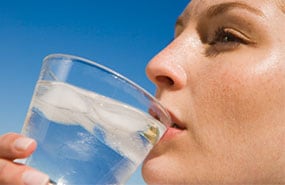Get the Facts: Data and Research on Water Consumption

Plain water consumption varies by age, race/ethnicity, and socioeconomic status.
- During 2015–2018, US children and adolescents drank an average of 23 ounces of plain water daily, and US adults drank an average of 44 ounces.
- Among US children and adolescents, plain water intake is significantly lower in younger children, non-Hispanic Black children or Hispanic children (compared to non-Hispanic White children), those living in lower-income households, youth whose head of household had less than a high school education (compared to college or higher), and those who are underweight or normal weight (compared to those with obesity) (Table 1).
- Among US adults, plain water intake is significantly lower in older adults, non-Hispanic Black adults (compared to non-Hispanic White adults), adults with lower income and lower education, and adults without obesity (Table 2).
Table 1
Mean Daily Plain Watera Intakes Among US Children and Adolescents Aged 2 to 19 Years, National Health and Nutrition Examination Survey 2015–2018b
Table 2
Mean Daily Plain Watera Intakes Among US Adults Aged 20 Years and Older, National Health and Nutrition Examination Survey 2015–2018b
Resources
- CDC Water Toolkits for Early Care and Education Settings and Schools
- Increasing Access to Drinking Water and Other Healthier Beverages in Early Care and Education Settings [PDF-3.68MB]
- Increasing Access to Drinking Water in Schools
- Water Access in Schools Microlearning Modules guide schools to help students drink more water during the day.
- Nutrition and Obesity Policy Research and Evaluation Network (NOPREN) Water Access Working Group:
This site provides information on this working group who focus on policies and economic issues regarding free and safe drinking water access. - Environmental Protection Agency (EPA)—Lead in Drinking Water at Schools and Childcare Facilities :
This site provides information about lead in drinking water at schools and child care facilities. - Environmental Protection Agency (EPA) – Find Your Local Consumer Confidence Report :
This site provides information on annual drinking water quality reports from local water suppliers. - Private Drinking Water Wells |US EPA:
This site provides information for private well owners. Private well owners are responsible for the safety of their water. This website educates well owners on wells, groundwater, and information on protecting their health. It is estimated that more than 13 million households rely on private wells for drinking water in the United States (US Census American Housing Survey 2017).
CDC Publications (2012-2022)
Youth
- Associations between household water fluoridation status and plain tap or bottled water consumption; September 2020
- Correlates of infrequent plain water intake among US high school students: National Youth Risk Behavior Survey, 2017; March 2020
- Dietary and physical activity behaviors among high school students – Youth Risk Behavior Survey, United States, 2019; August 2020
- A water availability intervention in New York City public schools: influence on youths’ water and milk behaviors; February 2015
- Student-reported school drinking fountain availability by youth characteristics and state plumbing codes; April 2014
- Perceptions of tap water and school water fountains and association with intake of plain water and sugar-sweetened beverages; March 2014
- Factors associated with low water intake among U.S. high school students – National Youth Physical Activity and Nutrition Study, 2010; September 2012
Adults
- Factors related to water filter use for drinking tap water at home and its association with consuming plain water and sugar-sweetened beverages among US adults; Jan 2022
- Perceptions of drinking water safety and their associations with plain water intake among U.S. Hispanic adults; August 2019
- Community-based policies and support for free drinking water access in outdoor areas and building standards in U.S. municipalities; April 2018
- The relationship of perceptions of tap water safety with intake of sugar-sweetened beverages and plain water among U.S. adults; January 2014
- Behaviors and attitudes associated with low drinking water intake among U.S. adults, Food Attitudes and Behaviors Survey, 2007; April 2013
Error processing SSI file
Page last reviewed: June 7, 2022
